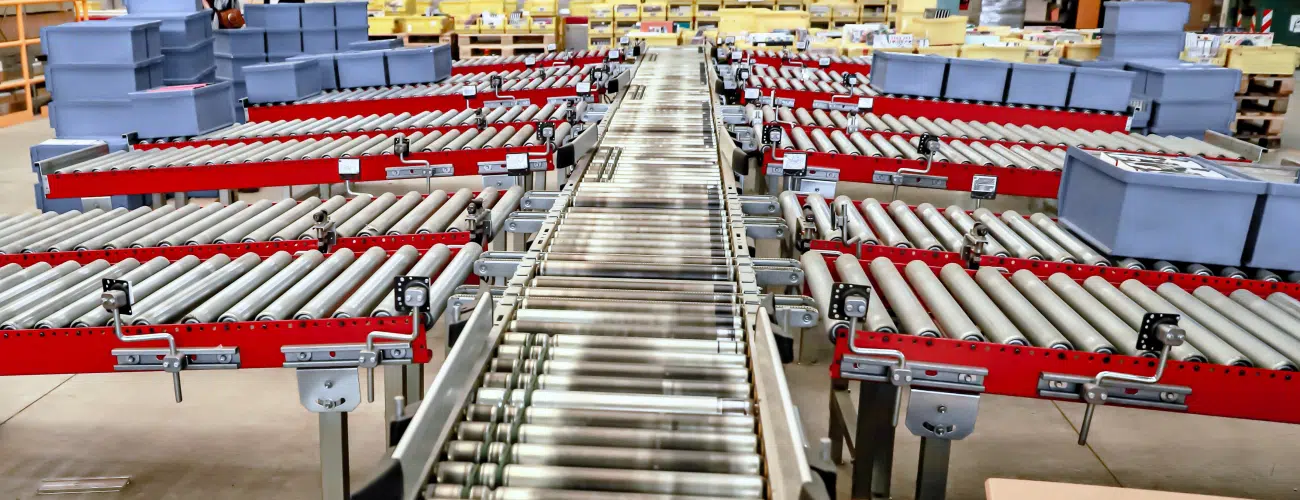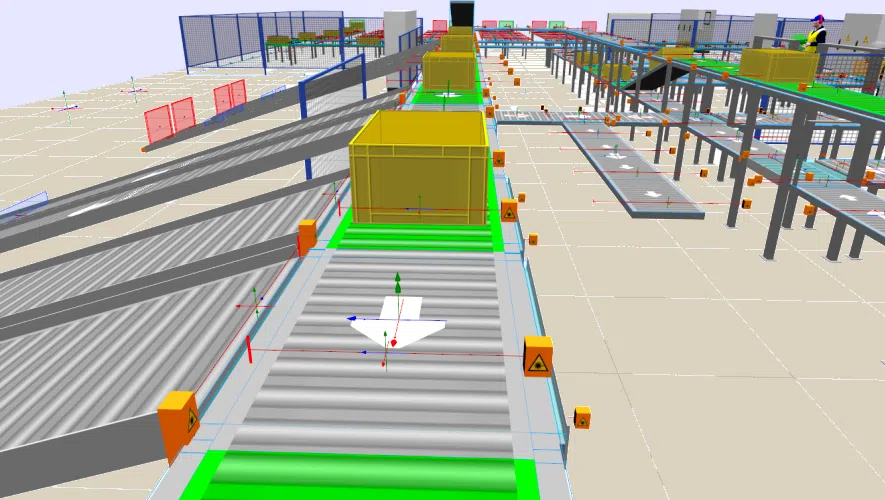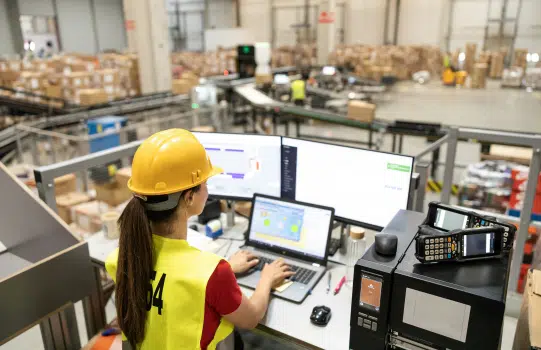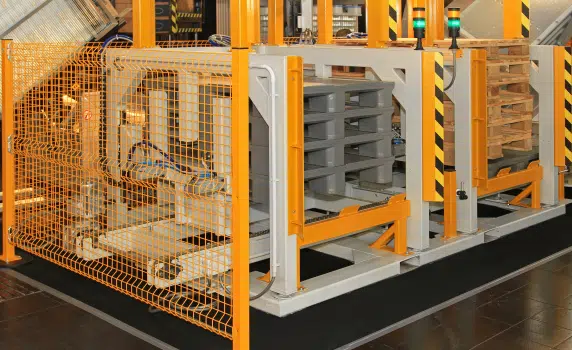Container & Pallet Conveying Systems
Factory automation solutions from WinMOD
Container Conveying Systems
Transport systems for cartons, containers and components
Conveyors and transfer systems
With the WinMOD-SIMLINE system, container and small parts conveyor systems can be put into operation completely virtually. This is based on an extensive 3D simulation library that includes roller conveyors and belt conveyors as well as typical components such as curved roller conveyors, belt curves and accumulation roller conveyors. The system is supplemented by lifting, transfer and gantry units for a wide variety of transfer processes. All 3D simulation elements can be parameterised with millimetre precision, allowing the real system to be reproduced in detail as a virtual model system based on the projected CAD drawings.
The WinMOD-SIMLINE 3D conveyor technology is then linked to virtual drive units. These come from the WinMOD libraries, are configured according to real specifications and range from simple switch drives to complex frequency converters. This concept allows maximum flexibility when combining different drive systems with the respective conveyor technology modules.



Sensors and material flow tracking
Unlike planning simulations, virtual commissioning also integrates the complete real sensor technology for material flow tracking. Here too, the WinMOD-SIMLINE system offers libraries for real-time 3D light barriers, sensors, scanners and laser measuring systems. These WinMOD-SIMLINE 3D sensors capture the contours of the 3D conveyed goods with precision, providing the automation system with exactly the same data as in the real plant.
Individual data such as barcodes or RFIDs can also be assigned to each conveyed material. These are read and written using WinMOD-SIMLINE 3D scanners and exchanged with the respective automation system via WinMOD reading points. This also makes it possible to test higher-level MES systems and optimise material flow, even in large plants.
Pallet Conveying Systems
Transport systems for cartons, containers and components
Chain conveyors, roller conveyors and magazines
The WinMOD-SIMLINE system offers a wide range of 3D elements for this technology – from roller conveyors and chain conveyors to rotary, lifting and traversing carriages to complex combinations of these modules. Pallet magazines and dispensers are also available to realistically represent the intermediate buffering of empty pallets in the layout. All components can be parameterised with millimetre precision – including conveyor distances, lifting and traversing paths, and mechanical interlocking. The result is a virtual system that corresponds to the real design in every respect.
You can select the appropriate virtual drive devices – whether switch drives, frequency converters, hydraulic or linear modules – directly from the WinMOD libraries and connect them seamlessly to the 3D conveyor elements.


Chain conveyors, roller conveyors and magazines
The WinMOD-SIMLINE system offers a wide range of 3D elements for this technology – from roller conveyors and chain conveyors to rotary, lifting and traversing carriages to complex combinations of these modules. Pallet magazines and dispensers are also available to realistically represent the intermediate buffering of empty pallets in the layout. All components can be parameterised with millimetre precision – including conveyor distances, lifting and traversing paths, and mechanical interlocking. The result is a virtual system that corresponds to the real design in every respect.
You can select the appropriate virtual drive devices – whether switch drives, frequency converters, hydraulic or linear modules – directly from the WinMOD libraries and connect them seamlessly to the 3D conveyor elements.
Further factory automation solutions
Sorting and picking systems for small items such as cartons, plastic boxes or other piece goods. Transport is via classic roller conveyors, belt conveyors
as well as the typical cam roller conveyors found here,
Belt curves and accumulation roller conveyors.
This area of technology encompasses conveyor systems that transport and sort pallets and mesh boxes. The conveyor elements are large roller and chain conveyors combined with lifting, rotating and shifting tables. Magazines for empty pallets are also typical here.
These systems are usually fully automated high-bay warehouses that are operated by storage and retrieval machines and controlled by distributed automation systems. Warehouse management systems generate the orders for storage and retrieval.
Automated systems that pick up parts from A to B and place them down again with a defined orientation – typically for loading, sorting, picking or packing. Core systems are industrial robots (Delta, SCARA, 6 axes, Cartesian) or gantry axes.
Robotics plays a central role in modern manufacturing by enabling the automation of production processes and increasing efficiency and precision. Robots are used in various areas, such as welding, assembly, painting or packaging products.
Production lines combine processes, material flow and controls into a production system with guaranteed cycle times and quality. They consist of combinations of assembly, processing and testing stations. In addition, there is transfer technology, buffers and often a highly specialised automation system.
Electric Monorail Systems are used as connecting conveyor technology over long distances. The overhead trolleys run fully automatically with integrated electric drives and controls and are usually routed via a central control system.
This chain-driven overhead or floor conveyor technology is powered by continuously running power strands (chains). Transport trolleys are coupled in, transported, decoupled at stoppers and buffered via chain drivers („dogs“).
Automated self-driving vehicles as a connecting material flow solution. Driving is either completely trackless via defined tracks or markers (AGV) or via free navigation with automatic dynamic obstacle avoidance (AMR).
Engineering discipline for the development, manufacture and maintenance of machines, plants and production systems. Typical applications include machine tools, handling technology, automotive/aerospace, packaging and assembly plants.